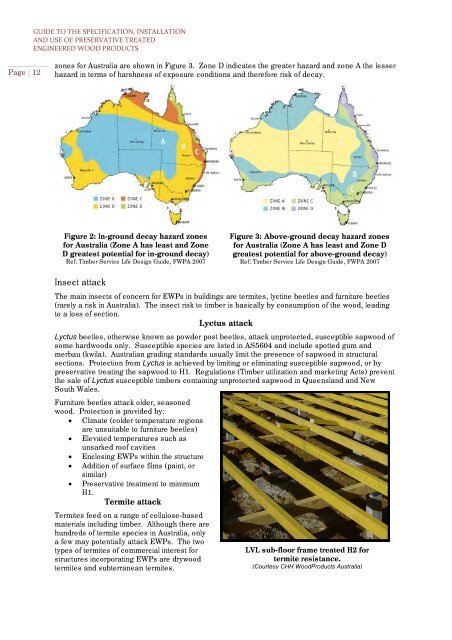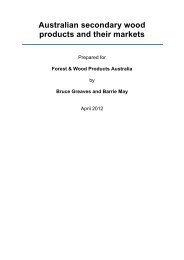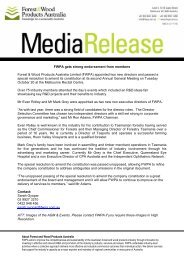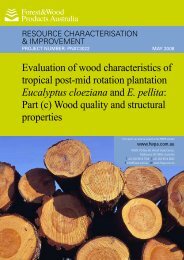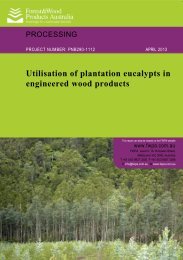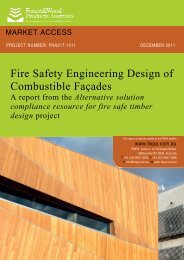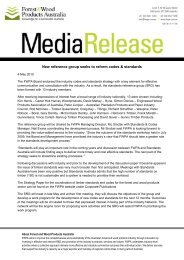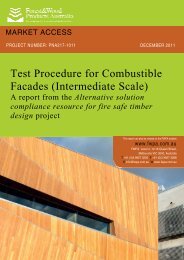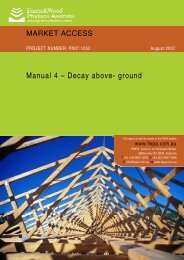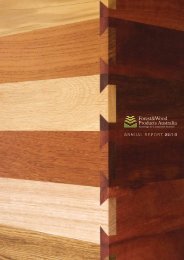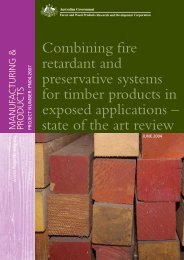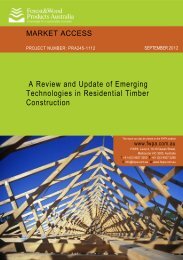guide to the specification, installation and use of preservative treated ...
guide to the specification, installation and use of preservative treated ...
guide to the specification, installation and use of preservative treated ...
You also want an ePaper? Increase the reach of your titles
YUMPU automatically turns print PDFs into web optimized ePapers that Google loves.
Page | 12<br />
GUIDE TO THE SPECIFICATION, INSTALLATION<br />
AND USE OF PRESERVATIVE TREATED<br />
ENGINEERED WOOD PRODUCTS<br />
zones for Australia are shown in Figure 3. Zone D indicates <strong>the</strong> greater hazard <strong>and</strong> zone A <strong>the</strong> lesser<br />
hazard in terms <strong>of</strong> harshness <strong>of</strong> exposure conditions <strong>and</strong> <strong>the</strong>refore risk <strong>of</strong> decay.<br />
Figure 2: In-ground decay hazard zones<br />
for Australia (Zone A has least <strong>and</strong> Zone<br />
D greatest potential for in-ground decay)<br />
Ref: Timber Service Life Design Guide, FWPA 2007<br />
Insect attack<br />
Figure 3: Above-ground decay hazard zones<br />
for Australia (Zone A has least <strong>and</strong> Zone D<br />
greatest potential for above-ground decay)<br />
Ref: Timber Service Life Design Guide, FWPA 2007<br />
The main insects <strong>of</strong> concern for EWPs in buildings are termites, lyctine beetles <strong>and</strong> furniture beetles<br />
(rarely a risk in Australia). The insect risk <strong>to</strong> timber is basically by consumption <strong>of</strong> <strong>the</strong> wood, leading<br />
<strong>to</strong> a loss <strong>of</strong> section.<br />
Lyctus attack<br />
Lyctus beetles, o<strong>the</strong>rwise known as powder post beetles, attack unprotected, susceptible sapwood <strong>of</strong><br />
some hardwoods only. Susceptible species are listed in AS5604 <strong>and</strong> include spotted gum <strong>and</strong><br />
merbau (kwila). Australian grading st<strong>and</strong>ards usually limit <strong>the</strong> presence <strong>of</strong> sapwood in structural<br />
sections. Protection from Lyctus is achieved by limiting or eliminating susceptible sapwood, or by<br />
<strong>preservative</strong> treating <strong>the</strong> sapwood <strong>to</strong> H1. Regulations (Timber utilization <strong>and</strong> marketing Acts) prevent<br />
<strong>the</strong> sale <strong>of</strong> Lyctus susceptible timbers containing unprotected sapwood in Queensl<strong>and</strong> <strong>and</strong> New<br />
South Wales.<br />
Furniture beetles attack older, seasoned<br />
wood. Protection is provided by:<br />
Climate (colder temperature regions<br />
are unsuitable <strong>to</strong> furniture beetles)<br />
Elevated temperatures such as<br />
unsarked ro<strong>of</strong> cavities<br />
Enclosing EWPs within <strong>the</strong> structure<br />
Addition <strong>of</strong> surface films (paint, or<br />
similar)<br />
Preservative treatment <strong>to</strong> minimum<br />
H1.<br />
Termite attack<br />
Termites feed on a range <strong>of</strong> cellulose-based<br />
materials including timber. Although <strong>the</strong>re are<br />
hundreds <strong>of</strong> termite species in Australia, only<br />
a few may potentially attack EWPs. The two<br />
types <strong>of</strong> termites <strong>of</strong> commercial interest for<br />
structures incorporating EWPs are drywood<br />
termites <strong>and</strong> subterranean termites.<br />
LVL sub-floor frame <strong>treated</strong> H2 for<br />
termite resistance.<br />
(Courtesy CHH WoodProducts Australia)


